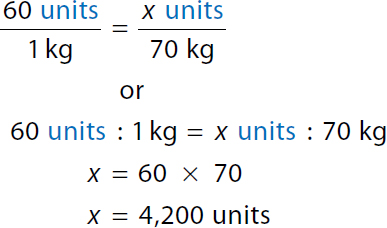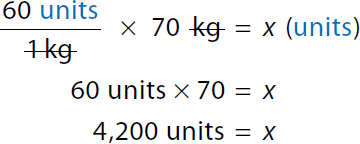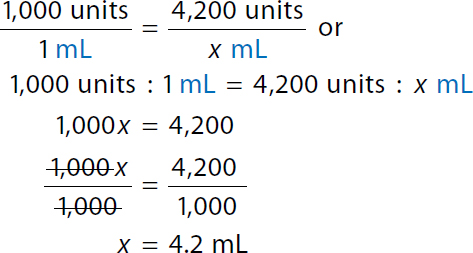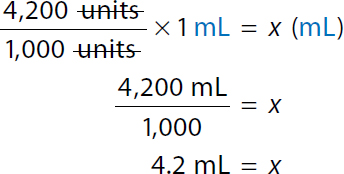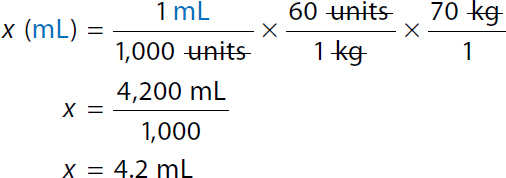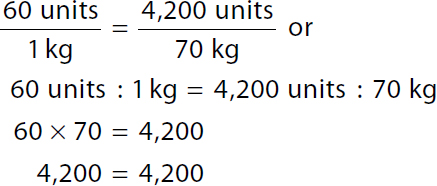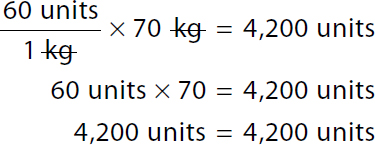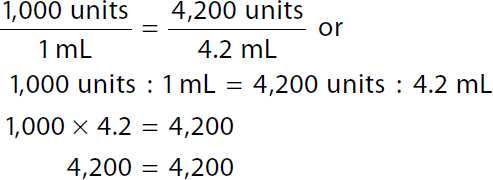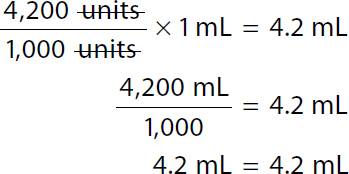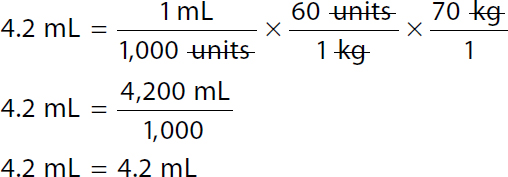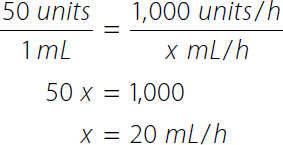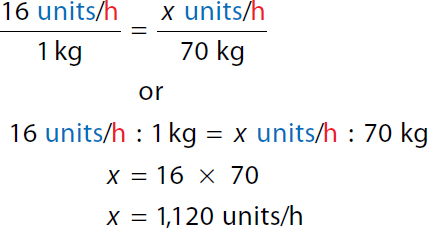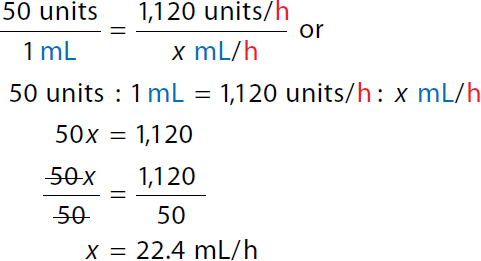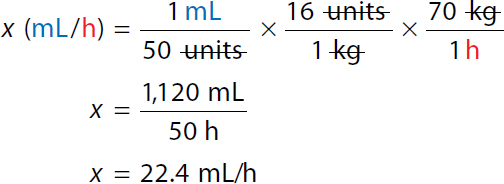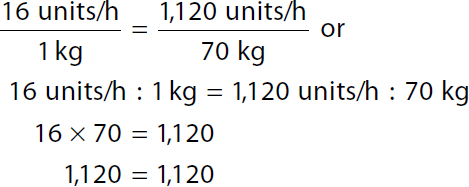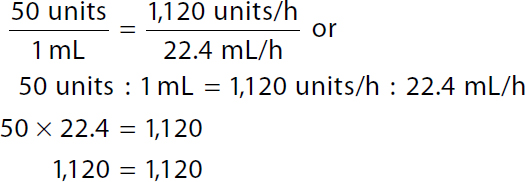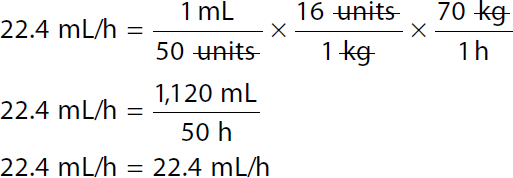Heparin is often administered as a continuous IV infusion with intermittent IV push (IVP) or bolus doses ordered as needed, based on the results of an intermittent lab test called activated partial thromboplastin time (aPTT). This blood test, measured in seconds, indicates how long it takes for blood to clot. The IV infusion rate is calculated separately from the IV bolus volume. Also, the IV infusion rate will be based on the concentration of the IV solution, whereas the IV bolus volume will be based on the dosage strength in the vial provided.
Clinical CLUE 14-4| Partial thromboplastin time (PTT) and aPTT are used to measure anticoagulation. An activator is added to the PTT to speed up clotting time (aPTT), which results in a narrower control range. In the 1970s, appropriate anticoagulation was determined to be 1.5 to 2.5 times the PTT control range. Heparin is dosed according to the aPTT. In general, the goal is 1.5 to 2.5 times the aPTT control range, depending on the patient's diagnosis. |
For weight-based heparin calculations, rounding is done according to equipment:
|
A weight-based heparin order will provide the number of units of heparin per 1 kg of body weight. This is a two-step process:
Step 1: Determine the number of units for the patient's weight in kilograms.
Step 2: Calculate the volume of heparin that contains the patient's dose.
Example: Use the following order and supply to calculate the amount, in milliliters, of heparin to administer to a 70 kg patient.
Order: Heparin 60 units/kg IV bolus now
Supply: Heparin 1,000 units/mL
C: Convert—Because the order and the supply are both in units, there is no conversion.
A: Approximate
Step 1: The ordered dose is 60 units per kg and the patient will need 70 times that amount (4,200 units) because the patient weighs 70 kg.
Step 2: Because there is 1,000 units of heparin per 1 mL, the volume to administer will be slightly more than 4 mL.
S: Solve
E: Evaluate
Ratio-Proportion | Formula Method |
|---|---|
Step 1: Calculate the bolus dose in units:
Calculation reads, 60 units over 1 kilogram equals 4,200 units over 70 kilograms, or a ratio of 60 units to 1 kilogram equals 4,200 units to 70 kilograms. 60 times 70 equals 4,200. 4,200 equals 4,200. Step 2: Calculate the volume to administer bolus dose in mL:
Calculation reads, 60 units over 1 kilogram equals x units over 70 kilograms. Ratio of 60 units to 1 kilogram equals ratio of x units to 70 kilograms. x equals 60 times 70. x equals 4,200 units. | Step 1: Calculate the bolus dose in units:
Calculation reads, 1,000 units over 1 milliliter equals 4,200 units over 4.2 milliliters, or a ratio of 1,000 units to 1 milliliter equals 4,200 units to 4.2 milliliters. 1,000 times 4.2 equals 4,200. 4,200 equals 4,200. Step 2: Calculate the volume to administer bolus dose in mL:
Calculation reads, 4,200 units over 1,000 units times 1 milliliter equals 4.2 milliliter. In both the numerator and the denominator units canceled each other. 4,200 milliliters over 1,000 equals 4.2 milliliters. 4.2 milliliters equals 4.2 milliliters. |
Dimensional Analysis | |
Steps 1 and 2 are combined:
A calculation to determine the volume to administer bolus dose in milliliters using dimensional analysis. Calculation reads, 4.2 milliliters equals 1 milliliter over 1,000 units times 60 units over 1 kilogram times 70 kilograms over 1. In both the numerator and the denominator units and kilograms canceled each other. 4.2 milliliters equals 4,200 milliliters over 1,000. 4.2 milliliters equals 4.2 milliliters. | |
Because the calculated dose, 4,200 units, accurately completes the (Step 1) equation and is consistent with the approximated dose, the answer is confirmed. Because the calculated volume, 4.2 mL, accurately completes the (Step 2) equation and is consistent with the approximated volume, the answer is confirmed.
Clinical CLUE 14-5To calculate the infusion rate for an hourly dose of medication, such as heparin 1,000 units/h, using ratio-proportion, the left ratio will be the supply (IV solution:  ) and the right ratio will be the order (IV rate: ) and the right ratio will be the order (IV rate:  ). ).
Calculation reads, 50 units over 1 milligrams equals 1000 units slash hour over x milligram. 50 x equals 1,000 x equals 20 milligrams per hour. |
LEARNING ACTIVITY 14-8 Use the following orders and supplies to calculate the heparin dose in units and the heparin amount to administer in mL.
1.Order: Heparin 40 units/kg IV bolus now for a patient who weighs 60 kg
Supply: Heparin 1,000 units/1 mL
2.Order: Heparin 35 units/kg IV bolus now; maximum dose 3,500 units for a patient who weighs 120 kg
Supply: Heparin 1,000 units/1 mL
A weight-based heparin infusion order will provide the number of units of heparin per 1 kg of body weight per hour. Calculating the rate is a two-step process:
Step 1: Determine the number of units/h based on the patient's weight in kilograms.
Step 2: Calculate the IV rate in mL/h that delivers the patient's hourly dose of heparin.
Example: Use the following order and supply to calculate the rate of heparin, in mL/h, for a 70 kg patient.
Order: Heparin 16 units/kg/h IV infusion
Supply: Heparin 25,000 units in 500 mL D5W (50 units/mL)
C: Convert—Because the order and supply are both in units, there is no conversion.
A: Approximate
Step 1: The ordered dose is 16 units/kg/h, so the patient will need more than 700 units/h (10 units/h × 70 kg) but less than 1,400 units/h (20 units/h × 70 kg).
Step 2: Because there are 50 units of heparin per 1 mL, the infusion will be between 14 and 28 mL/h (i.e. 700 units/h divided by 50 units/mL = 14 mL/h; 1400 units/h divided by 50 units/mL = 28 mL/h).
Ratio-Proportion | Formula Method |
|---|---|
Step 1: Calculate the dose in units/h:
Calculation reads, 16 units per hour over 1 kilogram equals x units per hour over 70 kilograms or a ratio of 16 units per hour to 1 kilogram equals ratio of x units per hour to 70 kilograms. x equals 16 times 70. x equals 1,120 units per hour. The patient's dose is 1,120 units/h. Step 2: Calculate the rate in mL/h:
A calculation to set the Ratio-Proportion to determine the infusion rate. Calculation reads, 50 units over 1 milliliter equals 1,120 units per hour over x milliliter per hour or a ratio of 50 units to 1 milliliter equals 1,120 units per hour to x milliliters per hour. 50 x equals 1,120. 50 x over 50 equals 1,120 over 50. In both the numerator and the denominator 50 canceled each other. x equals 22.4 milliliters per hour. The infusion rate is 22.4 mL/h. | Step 1: Calculate the dose in units/h:
Calculation reads, 16 units kilogram per hour times 70 kilograms equals x units per hour to 1,120 units per hour. The patient's dose is 1,120 units/h. Step 2: Calculate the rate in mL/h:
Calculation reads, 1120 units per hour over 50 units times 1 milliliter equals x milliliter per hour. 22.4 milliliters per hour equals x. The infusion rate is 22.4 mL/h. |
Dimensional Analysis | |
Steps 1 and 2 are combined:
Calculation reads, x start milliliter per hour equals 1 milliliter over 50 units times 16 units over 1 kilograms times 70 kilograms over 1 hour x equals 1120 milliliter over 50 hours x equals units 22.4 milliliter per hour. The infusion rate is 22.4 mL/h. | |
E: Evaluate
Because the calculated dose, 1,120 unit/h, accurately completes the (Step 1) equation and is consistent with the approximated dose, the answer is confirmed. Because the calculated rate, 22.4 mL/h, accurately completes the (Step 2) equation and is consistent with the approximated rate, the answer is confirmed.
Clinical CLUE 14-6| Increased accuracy is not the only advantage of using dimensional analysis to solve advanced clinical calculations. Another advantage is the ability to incorporate multiple conversion factors into one equation rather than performing multistep calculations. When using ratio-proportion or the formula method, weight-based heparin protocol calculations for weights given in pounds and ounces will require one or more conversion calculations in addition to the two-step process to determine bolus volumes or IV infusion rates. However, with dimensional analysis, additional conversions can be calculated within a single equation by inserting the appropriate conversion factors. |
LEARNING ACTIVITY 14-9 Refer to each order and supply to calculate the heparin dose in units/h and the heparin infusion rate in mL/h.
1.Order: Heparin 20 units/kg/h IV infusion (maximum rate 2,000 units/h) for a patient who weighs 90 kg
Supply: Heparin 25,000 units in 5% dextrose in water 500 mL (50 units/mL)
2.Order: Heparin 16 units/kg/h IV infusion for a patient who weighs 100 kg
Supply: Heparin 25,000 units in 5% dextrose in water 250 mL (100 units/mL)
